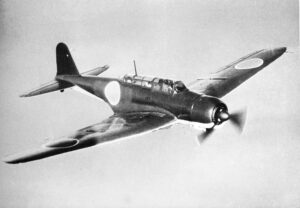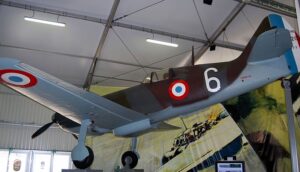Time Period: World War II
Country of Origin: Japan
Type: Fighter Aircraft
Manufacturer: Nakajima Aircraft Company
Nakajima Ki-84 Aircraft Overview
The Nakajima Ki-84 was a single-engine fighter aircraft developed by the Japanese company Nakajima Aircraft Company during World War II. The aircraft was also known by its Allied reporting name “Frank”.
The Ki-84 was designed to meet the Japanese army’s requirements for a high-performance fighter to counter the newer Allied fighters such as the P-38 Lightning and P-51 Mustang. The first prototype flew in March 1943, and the Ki-84 entered service with the Japanese army in early 1944.
The Ki-84 was a low-wing monoplane with a liquid-cooled inline engine and retractable landing gear. It was armed with two 20mm cannon and two 12.7mm machine guns mounted in the wings. Later variants of the Ki-84 were equipped with additional guns and rockets for ground attack missions.
The Ki-84 was considered one of the best Japanese fighters of the war, with excellent performance and maneuverability. It was fast and well-armed, and could outperform most Allied fighters in a dogfight. However, it suffered from a lack of spare parts due to Japan’s dwindling industrial resources, and was also vulnerable to engine reliability problems.
Despite these issues, the Ki-84 remained in service until the end of the war, and was used in several major campaigns, including the defense of the Philippines and the defense of Japan. It was also exported to other countries, including Thailand and Manchukuo.
Nakajima Ki-84-Ia Specifications
- Crew: One
- Length: 9.92 m (32 ft 7 in)
- Wingspan: 11.238 m (36 ft 10 in)
- Height: 3.385 m (11 ft 1 in)
- Wing area: 21 m2 (230 sq ft)
- Airfoil: root: NN-21(16.5%); tip: NN-21(8%)
- Empty weight: 2,660 kg (5,864 lb)
- Gross weight: 3,601.5 kg (7,940 lb)
- Max takeoff weight: 4,170 kg (9,193 lb)
- Powerplant: 1 × Nakajima Homare Model Ha-45-21 (or Models 11, 12, 21, 23 or 25) 18-cylinder air-cooled radial piston engine, 1,522 kW (2,041 hp) at sea level and 1,360 kW (1,820 hp) at 5,500 m (17,900 ft)
- Propellers: 4-bladed constant-speed metal propeller.
Nakajima Ki-84-Ia Performance
- Maximum speed: 687 km/h (427 mph, 371 kn) at 7,000 m (23,000 ft)
- Range: 2,168 km (1,347 mi, 1,171 nmi)
- Service ceiling: 11,826 m (38,799 ft)
- Rate of climb: 21.84 m/s (4,299 ft/min) at sea level. 18.29 m/s (3,600 ft/min) at 3,050 m (10,007 ft)
- Wing loading: 171.47 kg/m2 (35.12 lb/sq ft)
- Power/mass: 0.41 kW/kg (0.25 hp/lb)
Nakajima Ki-84-Ia Armament
- 2 × 12.7 mm (0.5 in) Ho-103 machine guns in nose, 350 rounds/gun.
- 2 × 20 mm (0.787 in) Ho-5 cannon in wings, 150 shells/cannon.
- 2 × 250 kg (550 lb) bombs.
- 2× 200 L (53 US gal) drop tanks.
Nakajima Ki-84 Image Gallery
More Nakajima Aircraft

Nakajima J1N “Gekko”
The Nakajima J1N “Gekko” is a twin-engine aircraft used by the Japanese Imperial Navy during World War II.

Nakajima Ki-43 Hayabusa
The Nakajima Ki-43 Hayabusa was a single-engine fighter aircraft used by the Imperial Japanese Army Air Service in World War II.

Nakajima B5N
The Nakajima B5N was a Japanese carrier-based torpedo bomber used during the Second World War by the Imperial Japanese Navy (IJN).

Nakajima A6M2-N
The Nakajima A6M2-N was a single-crew floatplane aircraft created in 1941 and based on the Mitsubishi A6M Zero Model 11.










